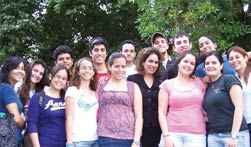By Gabriel Popkin

Photo courtesy of Michelle Iacoletti
Michelle Iacoletti, Project Manager for the APS Minority Bridge Program, with physics students at the Mayagüez campus of the University of Puerto Rico.
Currently, URMs (defined for this purpose as including African-Americans, Hispanic-Americans, and Native-Americans) make up a third of the country’s college-age population and around ten percent of the undergraduate physics majors in the country, but receive only five to six percent of the physics PhDs, according to data from the US Department of Education. “Minorities are under-represented in physics at all steps along the education pathway,” says Theodore Hodapp, Director of Education and Diversity at APS. “We have chosen to address the gap between bachelor’s and PhD recipients because this is where we can have the greatest impact.” MBP project leaders hope to close this gap through a multi-pronged approach that includes the identification of students with an interest in pursuing graduate degrees in physics, career guidance, development of appropriate undergraduate research opportunities, financial support, and mentoring.
“While several programs exist to increase the number of science, technology, engineering, and math (STEM) undergraduates going on to PhD programs, they tend to have limited success in physics,” says Michelle Iacoletti, who manages the MBP for APS. “The challenge unique to physics is one of applicability. Most minority students aren’t aware of the careers they can pursue with a physics degree, and lack role models with careers in science. Therefore, career awareness is a big focus of our program.”
Faculty at minority-serving institutions confirm that their students tend toward fields with high-visibility career pathways, such as medicine and engineering. “The student population we serve at the University of Texas at San Antonio is primarily first-generation, making engineering programs a popular choice. What we find, however, is that a lot of our engineering students are actually more interested in physics,” says Lorenzo Brancaleon, a physics professor at UTSA.
In the first phase of the project, APS staff members are visiting institutions that educate a significant number of minorities to talk to undergraduates and faculty members and identify their needs. “Personal contact with URM students is crucial in remediating the lack of awareness of physics careers. We won’t succeed by just mailing a brochure,” Hodapp maintains.
Project leaders are also assessing the commitment levels and resources available at a number of research institutions. A conference bringing together students and faculty from minority-serving institutions, faculty and administrators from research institutions, and representatives of successful existing bridge programs is planned for June 2010. The outcome will be a set of operational plans for successful bridge programs specifically tailored to physics undergraduates. Funding for the current efforts comes from the National Science Foundation.
“The under-representation of minorities in physics graduate programs is especially troubling because it leads to a shortage of minority faculty who can serve as mentors and role models to minority students,” says APS past-President Cherry Murray, who chairs the MBP’s steering committee. “We hope our efforts will ultimately lead to benefits for students at all educational levels.”

©1995 - 2024, AMERICAN PHYSICAL SOCIETY
APS encourages the redistribution of the materials included in this newspaper provided that attribution to the source is noted and the materials are not truncated or changed.
Editor: Alan Chodos
January 2010 (Volume 19, Number 1)
Articles in this Issue

